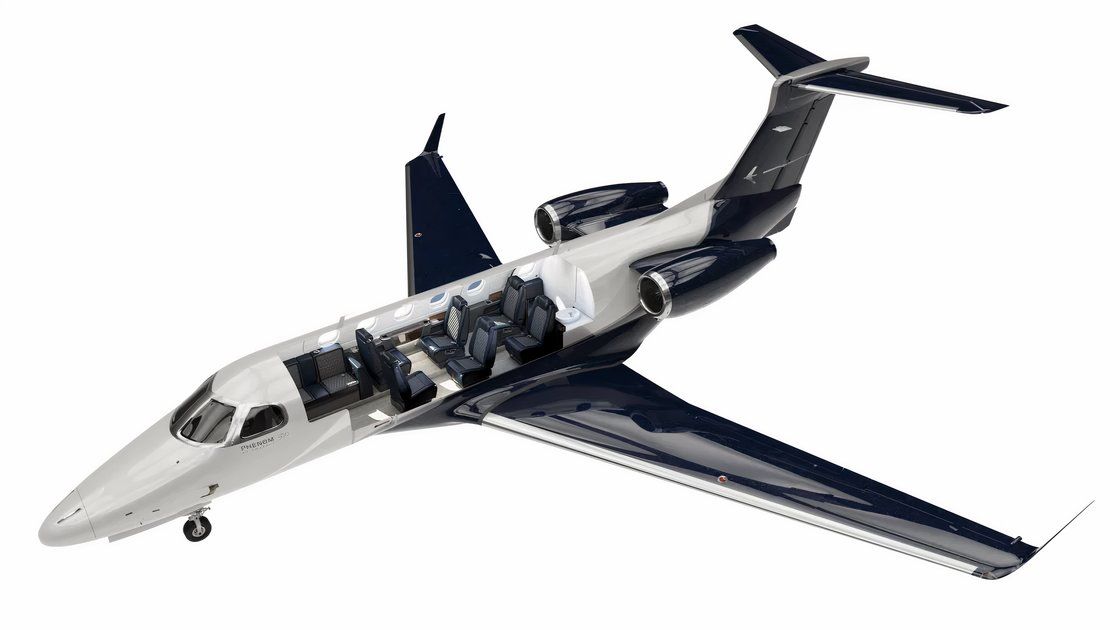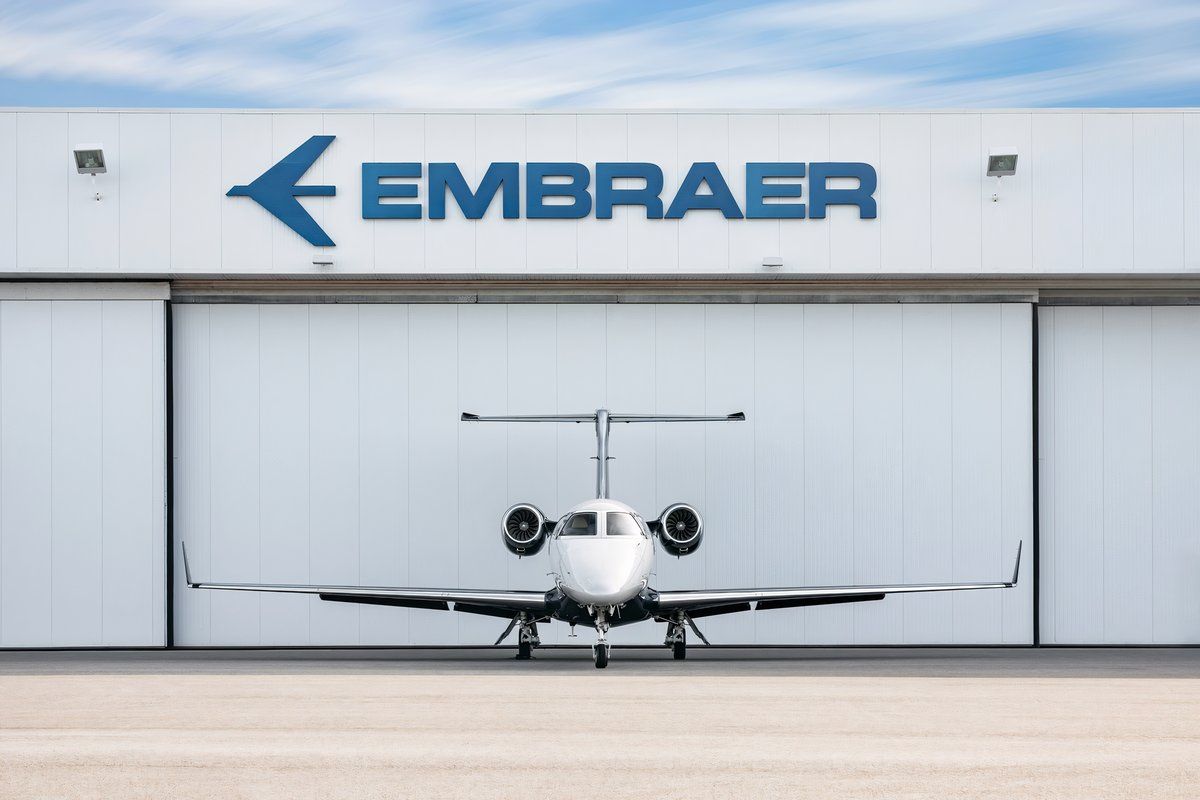
An In-Depth Guide To The Embraer Phenom 300
The Embraer Phenom 300 has become a cornerstone of the private jet market, earning its place as one of the most flown aircraft in 2024. Known for its performance, comfort, and reliability, the Phenom 300 continues to set benchmarks in the light jet category. In this guide, we explore what makes the Embraer Phenom 300 a top choice for private aviation, examining its history, technical prowess, and market dominance.
Overview of the Embraer Phenom 300
Introduced in 2009, the Embraer Phenom 300 has evolved through several upgrades, maintaining its position as a leader in the light jet segment. Built by Brazilian aerospace manufacturer Embraer, the aircraft combines cutting-edge technology with exceptional design. The latest model, the Phenom 300E, continues to dominate with advanced avionics, improved cabin comfort, and enhanced fuel efficiency.
The Phenom 300 has undergone various updates since its inception, including improved cabin pressurization, enhanced avionics, and increased cruising speed. Its reputation for reliability and performance has made it a preferred choice for business travelers, charter operators, and aviation enthusiasts worldwide.
Related
Embraer Fleet: A Look At The University Of Notre Dame Private Jets
The University flies two different Embraer Phenom 300s.
Key specifications
The Phenom 300’s appeal lies in its impressive technical specifications:
- Range: Up to 1,971 nautical miles (3172km)
- Maximum Cruise Speed: 451 mph (280 km/h), ensuring fast travel times
- Maximum Takeoff Weight (MTOW): 17,968 lbs (8,150 kg), supporting a variety of payload configurations
- Cabin Height: 4 ft 9 in (1.44 m), providing ample headroom
- Seating Capacity: 7 passengers, depending on configuration. The Phenom 300E can accommodate up to 11 passengers, but to get the full 11 passengers, the fully belted lavatory seat and the two-person divan near the entry door. No, that’s not a typo. According to Embraer, the lavatory can be equipped with a belt to accommodate a passenger
These features make the aircraft ideal for regional and transcontinental flights, capable of connecting cities such as New York and Miami or London and Rome without refueling.
Performance and efficiency
The Phenom 300 excels in both speed and efficiency. Powered by two Pratt & Whitney Canada PW535E1 engines, it delivers a maximum cruise speed of Mach 0.80. These engines are primarily used in the Embraer Phenom 300 and Phenom 300E models. Originally, the Pratt & Whitney PW500 engine was used, but this has been phased out since 2020. Their combination of power, efficiency, and reliability has made them popular in the business aviation sector, supporting private owners, charter operators, and corporate fleets worldwide. With a takeoff distance of just 3,209 feet (978 m) and a landing distance of 2,212 feet (674 m), the aircraft can access smaller airports, giving passengers greater flexibility.
Fuel efficiency is another highlight. Its advanced aerodynamics and efficient engines reduce operating costs while minimizing environmental impact, making it popular among charter operators and private owners. Additionally, the aircraft’s wing design and reduced drag contribute to improved fuel economy, giving it an edge over competitors.
Cabin experience
Comfort and style define the Phenom 300’s cabin. Embraer partnered with design firm BMW Designworks to craft an interior that balances elegance with functionality. The Phenom 300 typically seats 6-10 passengers, depending on the selected cabin configuration. The standard layout includes:
- Club Seating Arrangement: Four luxurious, fully adjustable seats arranged in a face-to-face “club” style for social interaction or business meetings. Seating options include a side-facing divan near the cabin entrance which seats up to two passengers as well as other configurations requested by the customer.
- Ergonomic Design: Seats are crafted with high-quality leather and memory foam cushions for optimal comfort during long flights. This includes features like adjustable armrests, headrests, and leg rests that ensure personalized comfort.
- Recline and Swivel Functionality: Each seat can fully recline and swivel up to 180 degrees, enabling multiple configurations, including fully flat seating when paired with the opposite seat in the club arrangement.
- Customization Options: Buyers can select from various upholstery materials, stitching patterns, and trim finishes, plus, Embraer offers several cabin color palettes inspired by modern luxury interiors.
Photo: Embraer S.A.
In-Flight Experience Enhancements
- Table and Workspace: Options include a variety of options including retractable, stowable tables between the club seats create a functional workspace or dining area. Plus, each seat features easy access to power outlets, USB ports, and in-flight entertainment controls.
Passenger Comfort Features
-
Spacious Design:
- The cabin is 4 feet 9 inches tall and 5 feet 1 inch wide, providing generous headroom and legroom.
-
Cabin Lighting and Ambiance:
- LED lighting can be adjusted for intensity and color, creating a relaxing or productive environment as needed.
-
Noise Reduction:
- Advanced soundproofing keeps cabin noise to a minimum, enhancing passenger comfort on long flights.
Why It Stands Out
The Phenom 300’s cabin seating combines luxurious design with ergonomic functionality. Its customizable layout, reclining seats, and modern tech integrations make it a standout in the light jet category. This thoughtful design helps ensure a first-class flying experience, whether for business or leisure.
Let me know if you’d like to explore specific customization packages or compare its seating with other private jets!
- Spacious seating: Ergonomic seats that fully recline and swivel, offering superior comfort
- Natural light: Large windows for an open, airy feel and improved passenger experience
- Advanced climate control: Ensures passenger comfort across diverse climates, maintaining optimal cabin conditions
- Entertainment and connectivity: High-speed Wi-Fi, custom in-flight entertainment systems, and adjustable lighting enhance the onboard experience
1:48

Related
Ultra-Long-Range Embraer? A Look At The Embraer Lineage 1000
Looking at this powerful aircraft from the Brazilian manufacturer.
Additionally, the Phenom 300 boasts the largest baggage compartment in its class, accommodating luggage for extended trips. Its fully enclosed lavatory and optional refreshment center further elevate the travel experience.
Avionics and technology
The avionics system in the Embraer Phenom 300 is built around the Garmin G3000-based Prodigy Touch flight deck, offering industry-leading technology for safety, situational awareness, and flight efficiency. The Prodigy Touch flight deck is designed for ease of use, reducing pilot workload while enhancing operational control. Its intuitive touch-screen interface, advanced automation, and customizable displays make it a favorite among pilots. Key features include:
Touchscreen control panels
- Primary Flight Displays (PFDs): Two 14.1-inch high-resolution screens provide clear and customizable flight data, including navigation, weather, and engine performance.
- Multi-Function Display (MFD): A center-mounted screen shows system diagnostics, navigation maps, and detailed flight data.
- Touchscreen Controllers: Two control units manage all avionics settings, reducing the need for physical buttons and knobs.
Navigation and Situational Awareness
- Synthetic Vision System (SVS): Provides a 3D terrain view, enhancing situational awareness in all weather conditions.
- WAAS/LPV Approaches: Allows for precision approaches at airports without ILS systems.
- Enhanced Map Overlays: Integrated maps display real-time terrain, traffic, and weather radar.
- Flight Management System (FMS): Simplifies route planning, fuel management, and waypoint adjustments.
Safety and Alert Systems
- Runway Overrun Awareness and Alerting System (ROAAS): A safety feature alerting pilots if runway conditions are unsafe for landing or takeoff.
- Traffic Collision Avoidance System (TCAS II): Provides real-time alerts about nearby aircraft, ensuring safe separation.
- Emergency Descent Mode (EDM): Automatically descends the aircraft in case of cabin pressurization loss.
- Autothrottle: Manages engine power automatically for safer, more efficient climbs, cruise, and descent phases.
Communication and Connectivity
- Digital Audio Panel: Ensures clear communication between pilots and air traffic control.
- Data Communication (Datalink): Supports automatic weather updates, flight plan uploads, and text communications with air traffic services.
Weather and Environmental Monitoring
- Weather Radar: Displays precipitation intensity, storm cells, and wind shear warnings.
- Radar Altimeter: Provides accurate altitude readings, crucial during low-visibility landings.
- Enhanced Ground Proximity Warning System (EGPWS): Issues alerts when the aircraft is too close to terrain.
Autopilot and Automation
- Automatic Flight Control System (AFCS): Manages autopilot functions for smooth and precise flight control.
- Flight Director: Guides the pilot through takeoff, climb, cruise, and approach using optimal flight paths.
Photo: Embraer S.A.
The Phenom 300’s avionics suite excels in combining cutting-edge technology with user-friendly design. Its safety-first approach, intuitive touchscreen interface, and unparalleled automation make it a top choice among pilots and operators worldwide.
Market success and fleet presence
The Phenom 300 has consistently been the world’s best-selling light jet since 2013. In 2024, its market presence expanded further due to strong demand from fractional ownership programs, charter services, and corporate flight departments.
According to Embraer’s 2024 market report, over 700 Phenom 300s are currently in service worldwide. North America remains the largest market, followed by Europe and Latin America. Major operators such as NetJets, Flexjet, and Executive AirShare have invested heavily in the Phenom 300 fleet, ensuring its continued visibility in the global aviation landscape.
The aircraft’s strong resale value and proven reliability have also driven its success, attracting new buyers and retaining long-term customers.
Why the Phenom 300 dominates 2024
The Phenom 300’s success stems from its balance of performance, comfort, and cost-efficiency. Its ability to serve a variety of missions — from business travel to medical evacuations — underscores its versatility.
In an increasingly competitive aviation market, Embraer’s continuous innovations and customer-centric enhancements have secured the Phenom 300’s place as the most flown aircraft in 2024. Its adaptability to various operational needs, from personal ownership to large fleet operations, highlights its broad appeal.
Looking ahead
As demand for private air travel continues to grow, the Phenom 300’s future looks promising. Industry analysts predict sustained popularity, driven by its unmatched combination of range, performance, and comfort.
The Embraer Phenom 300’s legacy is a testament to engineering excellence and market foresight, making it a dominant force in aviation in 2024 and beyond.





